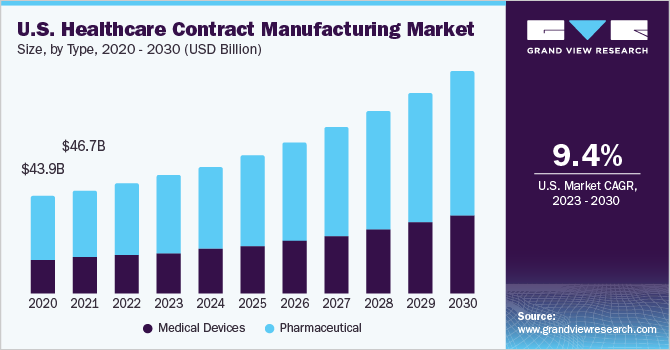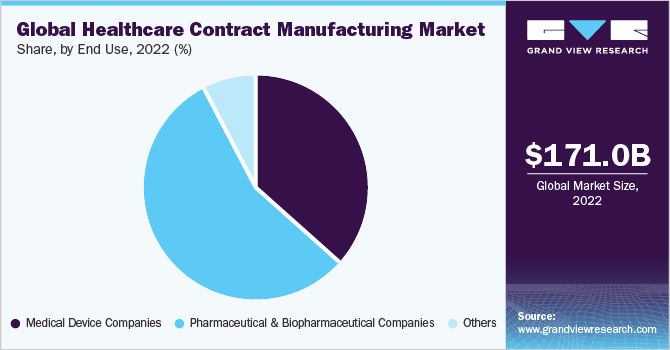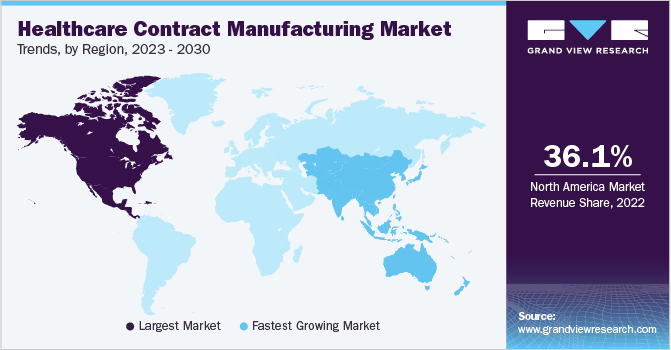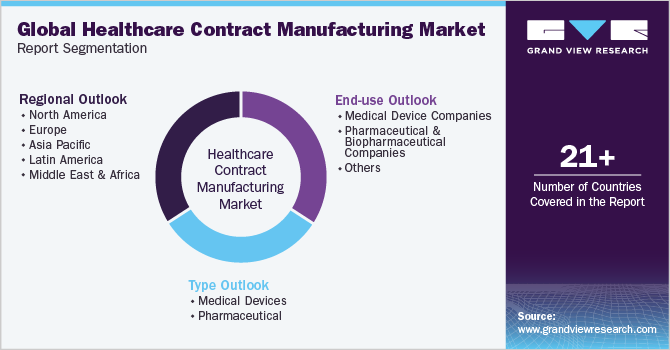- Home
- »
- Medical Devices
- »
-
Healthcare Contract Manufacturing Market Size Report, 2030GVR Report cover
![Healthcare Contract Manufacturing Market Size, Share & Trends Report]()
Healthcare Contract Manufacturing Market Size, Share & Trends Analysis Report By Type (Medical Devices, Pharmaceutical), By End-use (Medical Device Companies), By Region, And Segment Forecasts, 2023 - 2030
- Report ID: GVR-3-68038-128-3
- Number of Report Pages: 175
- Format: PDF, Horizon Databook
- Historical Range: 2018 - 2021
- Forecast Period: 2023 - 2030
- Industry: Healthcare
Report Overview
The global healthcare contract manufacturing market size was valued at USD 171.0 billion in 2022 and is projected to grow at a compound annual growth rate (CAGR) of 9.5% from 2023 to 2030. An increase in offshoring, especially in emerging countries, and changing regulatory landscape, are the prominent trends exhibited by this market. Pharmaceutical and medical device companies are outsourcing low-end services to third parties (CMOs) to reduce the overall cost of production and speed up the time to market of products. This trend is expected to contribute to the growth of the contract manufacturing market in the foreseeable future.

COVID-19 brought in unparalleled demand for diagnostic tests, Personal Protective Equipment (PPE), ventilators, and other critical medical supplies. COVID-19 has had a major impact on the supply-demand gap, with a 1,000 to 2,000-fold increase for PPE products, raw material shortages increased by over 10% thereby pushing the by more than 100% in 2020.
The COVID-19 pandemic has forced many pharmaceutical and medical device companies to increase the manufacturing of drugs and medical devices needed by infected patients worldwide. The U.S. FDA has observed that over 60% of FDA-regulated products imported from China are medical devices, making U.S. medical device industry highly dependent on China’s supply chain. Medical device manufacturers are facing severe supply bottlenecks, which will ultimately reduce the company’s scope of revenue generation.
The presence of end-to-end service providers that are engaged in providing value-added services for an integrated or risk-sharing business model is expected to boost the market growth. Pharmaceutical and medical device companies are outsourcing manufacturing activities to CMOs to reduce their manufacturing footprint. It allows manufacturers to be more dynamic and cost-effective in their manufacturing process.
In addition, factors such as the increasing rate of noninvasive surgical procedures are driving the demand for pharmaceutical drugs and medical devices. To meet such increased demand, OEMs are outsourcing the manufacturing of non-core manufacturing activities as it assists them in reducing labor costs, freeing up capital, increasing worker productivity, and improving manufacturing lead times. For many large, medium and small pharma firms, outsourcing turns out to be an economic option, as fixed costs for manufacturing biologics products account for around 60-70% of the Cost of Goods Sold (COGS) and cannot be avoided even during idle conditions.
Therefore, the use of multi-product facilities to produce biologics has been proven economically efficient and safe as there is negligible to no risk with respect to product carryover, thereby supporting market growth. Since the medical device industry is highly regulated, making rapid changes in the supply chain may not be manageable. Medical device manufacturers distributing products in the U.S. are not required to report actual or potential supply chain shortages to the FDA. Despite this, the FDA is actively addressing potential shortages in the medical device supply chain. Some of the products facing shortage are aluminum products, integrated circuits, lithium-ion batteries, and special components, including pneumatic fittings, black body radiation source, and platinum.
This has created an unprecedented demand for the manufacturing of Active Pharmaceutical Ingredients (APIs), finished doses, and medical devices in order to maintain supply. According to Medical Product Outsourcing, manufacturers expect outsourcing to yield cost savings and faster time to market, which is further anticipated to boost demand for the healthcare CRO market.
Type Insights
The pharmaceutical segment accounted for the largest revenue share of 65.1% in 2022. The medical device segment is further divided on the basis of type and therapeutic area. The type segment includes accessories, assembly, component, and device manufacturing. The device manufacturing segment is anticipated to dominate the contract manufacturing market over the forecast period owing to the increasing outsourcing of device manufacturing due to the lack of in-house manufacturing facilities and complexity. On the basis of therapeutic areas, the medical devices segment is analyzed for cardiology, medical imaging, orthopedic, IVD, ophthalmic, general & plastic surgery, drug delivery, dental and other areas. Based on type the industry is segmented into pharmaceutical and medical devices.
The cardiology segment held the largest share in 2022. The rising demand for cardiovascular devices as a result of increasing cases of associated conditions is attributed to the growth of outsourcing of these devices. Moreover, the high complexity of cardiovascular devices and the need for technical expertise result in higher outsourcing of these devices. The pharmaceutical segment is divided into Active Pharmaceutical Ingredients (APIs), advanced drug delivery formulations, packaging, and finished dose formulations.
Being the key component in drug development, APIs captured the largest revenue share of 63.8% in 2022 and are expected to witness significant growth during the forecast period. Several companies are opting for the outsourcing of drug development due to limited capacity, insufficient resources, and lack of skilled professionals, as well as for cost-saving. Various CMOs offer customized services. Services offered by CMOs range from the manufacturing of API/bulk drugs to finished dose formulations.
End-use Insights
The pharmaceutical and biopharmaceutical companies segment dominated the market in 2022 with a revenue share of 55.6%. Several biotechnology and pharmaceutical companies, such as Bristol-Myers Squibb (BMS), GlaxoSmithKline, Novartis, Eli Lilly and Company, and AstraZeneca, are investing in manufacturing biologics. The biologics market has grown significantly to incorporate novel product categories, such as synthetic vaccines, nanobodies, fusion proteins, rDNA, immunoconjugates, soluble receptors, and immunotherapeutics. While biologics have revolutionized disease therapy, this industry has presented several chances to investigate hybrid architectures that mix biologics with well-defined chemical entities. The need for outsourcing biologics manufacturing is anticipated to increase due to the growing demand for biologics. Hence, the pharmaceutical & biopharmaceutical companies are significantly outsourcing the contract manufacturing of biologics to CMOs, thereby boosting the segment’s growth.
In addition, since many pharmaceutical companies have products in various life cycle stages, aligning the regulation and products with respective market standards regarding drug registrations, approvals, and market entry is challenging. Thus, outsourcing pharmaceutical manufacturing services enables these companies to ensure compliance with market-specific regulations cost-effectively and efficiently. An increase in approved pharmaceutical products is also anticipated to fuel the market. For instance, according to FDA, in 2022, the FDA's Center for Drug Evaluation and Research (CDER) approved 37 new drugs as New Molecular Entities (NMEs) under the New Drug Applications (NDAs) or as new therapeutic biological products under the Biologics License Applications. Hence, the aforementioned factors are anticipated to support the high shares of the segment across the analysis timeframe.

The medical device companies’ segment is poised to witness a substantial CAGR of 9.4% from 2023 to 2030. Advancements in electronics, material science, & software solutions, the rising complexity of drug-device therapies, and the increasing adoption of wearable medical devices have led to a paradigm shift in the manufacturing process and market competition of medical devices. The abovementioned factors have increased the cost of in-house manufacturing, thereby outsourcing to industry expert service providers, enabling market players to focus on their core competencies and offer quality products at affordable costs. Increased stringent regulations and cost pressures have a major impact on the medical device manufacturing industry. Manufacturing high-quality and safe devices for patient care is a major concern for medical device manufacturers. Moreover, the regulations related to medical devices are vast and complicated due to legal technicalities. Consequently, companies are shifting their focus toward innovation rather than noncore activities, and thus outsourcing manufacturing services has enabled market players to minimize business risks, expedite product market entry, and reduce costs.
Regional Insights
North America dominated the healthcare contract manufacturing market in 2022 with a revenue share of 36.1%. The presence of several established biotechnology, pharmaceutical, and medical device companies characterize it. Furthermore, growing R&D investments by life sciences and pharmaceutical companies are anticipated to increase the region’s contract manufacturing demand. In addition, stringent regulations regarding manufacturing and quality of products are also anticipated to create growth opportunities for domestic contract manufacturing services.
According to an article published by CNN Business, the labor costs in China are nearly 4% less than that in the U.S. In addition, the cost and time involved in offshore production also reduce the cost-effectiveness and productivity of the manufacturing process. Thus, improved productivity due to domestic manufacturing is anticipated to fuel market growth in the U.S. High client satisfaction is also anticipated to fuel the country’s contract manufacturing growth. For instance, according to a study by Consumer Reports, Inc. in 2021, 8 out of 10 Americans prefer a Made in America product over an imported one, while according to another study published by the Inc. magazine (Mansueto Ventures), nearly 85% of the U.S. consumers believe that Made in America products are of higher quality.

In addition, the expansion of foreign contract manufacturing companies into the country is expected to propel the market growth. The 2022 U.S.-China trade tensions resulted in 18% drop in medical equipment and supplies import. Country’s manufacturing market regarding supply chain disruptions, import-export tariffs issues, and inventory overhangs was evidently impacted by the same.
Asia Pacific (APAC) region is anticipated to witness a lucrative growth of 10.6% during the forecast period owing to improving healthcare services and the economic growth of developing economies. Asia Pacific is one of the most attractive markets for contract manufacturing. This can be attributed to supportive regulatory reforms, especially in countries such as India, and cost-saving opportunities present in Asian countries. Furthermore, cGMP-compliant facilities and established market players in the region are also anticipated to fuel market growth. Moreover, China is a leading producer of low-cost electronic chips and products. Thus, it is expected to attract a significant number of investors. In addition, the ease of doing business in Asia Pacific is high due to low manufacturing costs, tax benefits, and availability of skilled labor at relatively low costs. However, the difference in time zones, culture, language, and intellectual property rights issues may limit the market growth.
India is emerging as one of the lucrative global contract manufacturing markets. This can be attributed to low manufacturing costs, availability of low-cost labor, and the presence of WHO-cGMP-compliant facilities & skilled workforce. According to an article by The Pharma Letter, operational costs in India were 40% less than in other countries, thus presenting huge economic benefits for multinational companies.
Key Companies & Market Share Insights
In this consolidated market, to sustain the competitive environment and maintain profitability, companies are adopting mergers, acquisitions, and expansion as key strategies.
-
In February 2023, Lonza announced the expansion of its bioconjugation facility in Switzerland. It has significantly extended Lonza’s customer portfolio, including companies entering clinical manufacturing.
-
In March 2023,CURIA,Albany Molecular Research Inc. (AMRI), collaborated with Corning to drive advancements in biopharmaceutical continuous-flow development and manufacturing programs.
-
November 2022, Medeologix, a Taiwan MedTech contract manufacturing company, announced the acquisition of three medical device companies to form a full-function integrated service group. This enhanced the company’s design & development capabilities, further supporting it to position itself as a prominent contract manufacturer for medical devices across the interventional and surgical device landscape.
Some of the prominent players in the healthcare contract manufacturing market include:
-
Nordson Corporation
-
Integer Holdings Corporation
-
Jabil Inc.
-
Viant Technology LLC
-
FLEX LTD.
-
Celestica Inc.
-
Sanmina Corporation
-
Plexus Corp.
-
Phillips-Medisize
-
West Pharmaceutical Services, Inc.
-
Synecco Ltd
-
Catalent, Inc.
-
Thermo Fisher Scientific Inc.
-
Recipharm AB
-
Boehringer Ingelheim International GmbH
-
Lonza
-
Samsung Biologics
-
WuXi AppTec
-
FUJIFILM Diosynth Biotechnologies
-
Cambrex Corporation
Healthcare Contract Manufacturing Market Report Scope
Report Attribute
Details
Market size value in 2023
USD 183.7 billion
Revenue Forecast in 2030
USD 347.5 billion
Growth rate
CAGR of 9.5% from 2023 to 2030
Base year for estimation
2022
Historical data
2018 - 2021
Forecast period
2023 - 2030
Report updated
June 2023
Quantitative units
Revenue in USD billion and CAGR from 2023 to 2030
Report Coverage
Revenue forecast, company share, competitive landscape, growth factors and trends
Segments Covered
Type, end use, region
Regional scope
North America; Europe; Asia Pacific; Latin America; Middle East & Africa
Country scope
U.S.; Canada; UK; Germany; France; Italy; Spain; Denmark; Sweden; Norway; Belgium; Netherlands; China; India; Japan; Australia; Thailand; South Korea; Philippines; Malaysia; Singapore; New Zealand; Brazil; Mexico; Argentina; Colombia; Chile; South Africa, Saudi Arabia; UAE; Kuwait; Israel
Key companies profiled
Nordson Corporation; Integer Holdings Corporation; Jabil Inc.; Viant Technology LLC; FLEX LTD.; Celestica Inc.; Sanmina Corporation; Catalent, Inc.; Thermo Fisher Scientific Inc.; Recipharm AB; Boehringer Ingelheim International GmbH; Lonza; Samsung Biologics; WuXi AppTec; FUJIFILM Diosynth Biotechnologies; Cambrex Corporation
Customization scope
Free report customization (equivalent up to 8 analysts working days) with purchase. Addition or alteration to country, regional & segment scope.
Pricing and purchase options
Avail customized purchase options to meet your exact research needs. Explore purchase options
Global Healthcare Contract Manufacturing Market Report Segmentation
This report forecasts revenue growth at global, regional, country levels and provides an analysis of the latest industry trends in each of the sub-segments from 2018 to 2030. For the purpose of this study, Grand View Research has segmented the global healthcare contract manufacturing market report on the basis of type, end use, and region:

-
Type Outlook (Revenue, USD Billion, 2018 - 2030)
-
Medical Devices
-
Service
-
Accessories manufacturing
-
Assembly manufacturing
-
Component manufacturing
-
Device manufacturing
-
-
Therapeutic Area
-
Cardiology
-
Diagnostic imaging
-
Orthopedic
-
IVD
-
Ophthalmic
-
General & plastic surgery
-
Drug delivery
-
Dental
-
Endoscopy
-
Diabetes care
-
Others
-
-
-
Pharmaceutical
-
API/Bulk Drugs
-
Advanced drug delivery formulations
-
Packaging
-
Finished dose formulations
-
Solid
-
Liquid
-
Semi-solid formulations
-
-
-
-
End-use Outlook (Revenue, USD Billion, 2018 - 2030)
-
Medical Device Companies
-
Pharmaceutical & Biopharmaceutical Companies
-
Others
-
-
Regional Outlook (Revenue, USD Billion, 2018 - 2030)
-
North America
-
U.S.
-
Canada
-
-
Europe
-
UK
-
Germany
-
France
-
Italy
-
Spain
-
Denmark
-
Sweden
-
Norway
-
Belgium
-
Netherlands
-
-
Asia Pacific
-
Japan
-
China
-
India
-
Australia
-
South Korea
-
Thailand
-
Philippines
-
Malaysia
-
New Zealand
-
Singapore
-
-
Latin America
-
Brazil
-
Mexico
-
Argentina
-
Colombia
-
Chile
-
-
Middle East & Africa
-
South Africa
-
Saudi Arabia
-
UAE
-
Kuwait
-
Israel
-
-
Frequently Asked Questions About This Report
b. The global healthcare contract manufacturing market size was estimated at USD 171.0 billion in 2022 and is expected to reach USD 183.7 billion in 2023.
b. The global healthcare contract manufacturing market is expected to grow at a compound annual growth rate of 9.5% from 2023 to 2030 to reach USD 347.5 billion by 2030.
b. North America dominated the healthcare contract manufacturing market with a share of 36.1% in 2022. The presence of several established biotechnology, pharmaceutical, and medical device companies characterizes it. Furthermore, growing R&D investments by life sciences and pharmaceutical companies are anticipated to increase the region’s contract manufacturing demand.
b. Some key players operating in the healthcare contract manufacturing market include Nordson Corporation; Integer Holdings Corporation; Jabil Inc.; Viant Technology LLC; FLEX LTD.; Celestica Inc.; Sanmina Corporation; Plexus Corp.; Phillips-Medisize; West Pharmaceutical Services, Inc.; Synecco; Catalent, Inc.; Thermo Fisher Scientific Inc.; Recipharm; Boehringer Ingelheim International GmbH; Lonza; Samsung Biologics; WuXi AppTec; FUJIFILM Diosynth Biotechnologies and Cambrex Corporation
b. Key factors are the rising prevalence of chronic disorders, increasing aging population, and increasing outsourcing of devices due to extensive use and complexity in manufacturing.
Share this report with your colleague or friend.
![gvr icn]()
NEED A CUSTOM REPORT?
We can customize every report - free of charge - including purchasing stand-alone sections or country-level reports, as well as offer affordable discounts for start-ups & universities. Contact us now
![Certified Icon]()
We are GDPR and CCPA compliant! Your transaction & personal information is safe and secure. For more details, please read our privacy policy.
We are committed towards customer satisfaction, and quality service.
"The quality of research they have done for us has been excellent."





